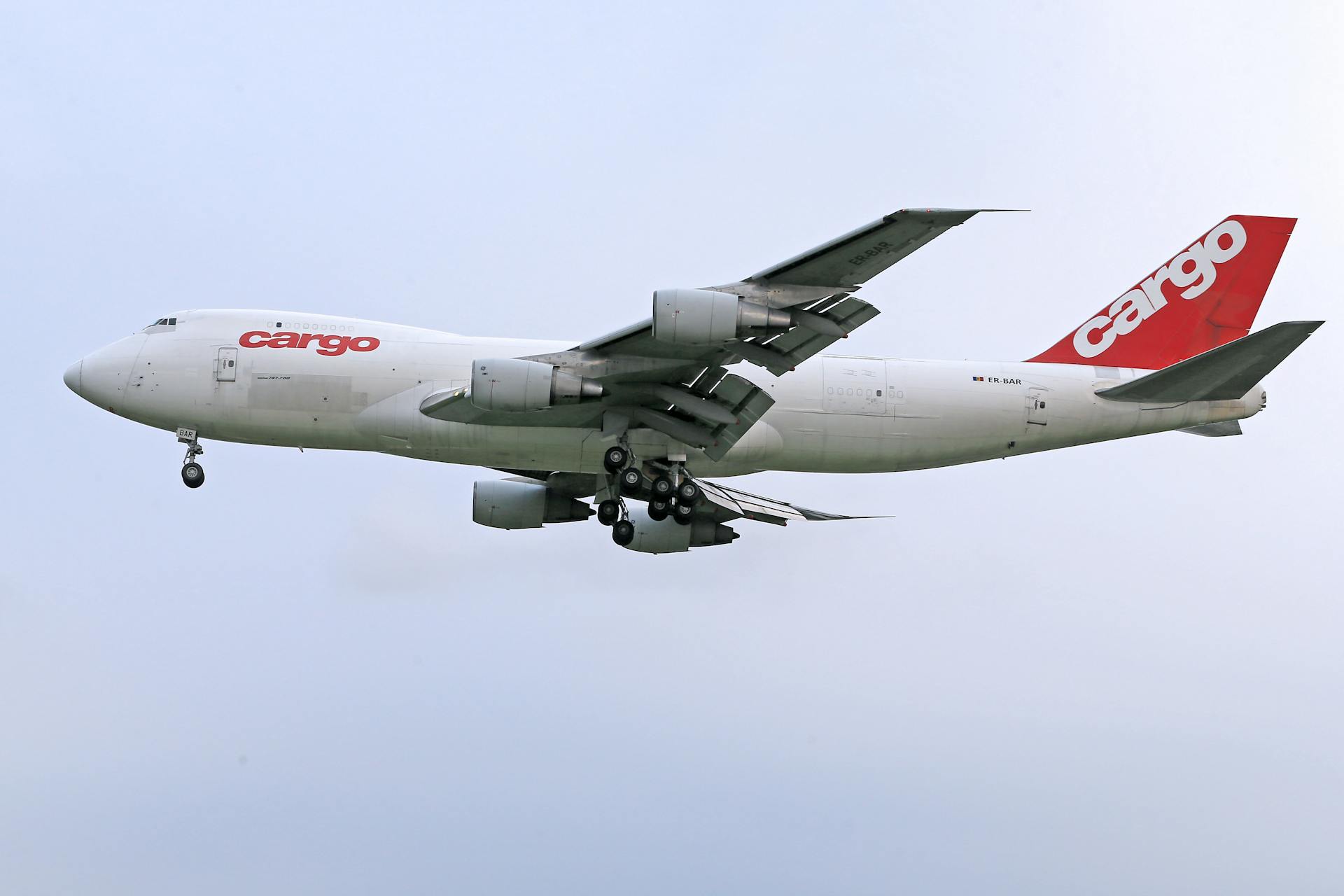
Shipping air cargo from India to the USA can be a complex process, but with the right information, you can ensure a smooth and efficient experience. The distance between India and the USA is approximately 8,000 miles, which can impact transit times and costs.
To start, you'll need to determine the type of air cargo you're shipping, which can be classified as general cargo, perishable cargo, or oversized cargo. Each type requires special handling and documentation.
The USA has several major airports that receive air cargo from India, including Los Angeles International Airport (LAX) and John F. Kennedy International Airport (JFK). These airports have the necessary infrastructure and facilities to handle large volumes of air cargo.
In India, major airports such as Mumbai's Chhatrapati Shivaji Maharaj International Airport (CSMIA) and Delhi's Indira Gandhi International Airport (IGIA) are key hubs for air cargo exports to the USA.
Readers also liked: List of Busiest Airports by Cargo Traffic
Shipping Options and Costs
Shipping options and costs can be overwhelming, especially when shipping from India to the USA. You have two main options: air freight and sea freight.
Air freight is more expensive than sea freight, but it's worth it if you need speed, are a risk-averse shipper, have delicate cargo, or are shipping high-value items.
The shipping cost of air freight from India to the USA varies depending on the type of cargo, weight, and distance. It can range from USD 2.50 to USD 5.00 per kilogram.
For small shipments, air shipping can be more cost-effective due to fewer port charges compared to sea freight. However, the decision between air and sea freight ultimately depends on the urgency of the shipment and its size.
To optimize your shipping strategy, consider selecting the best shipping terms, such as FOB, for transparent cost assessment and consult with a reputable freight forwarder.
Here's a rough estimate of the shipping costs from India to the USA:
Keep in mind that these estimates can vary depending on the specific shipping scenario. It's essential to get a quote from a freight forwarder to determine the best option for your business.
Trade Lane and Logistics
India and the USA are two of the world's manufacturing powerhouses, making shipping freight between the two nations essential for many businesses.
Shipping from India to the USA is a long haul, but both countries have large consumer markets, making importation a crucial aspect of business.
India and the USA have key ports and airports that play a vital role in shipping freight, including transit times, customs clearance, and documentation.
Partner with a reliable international logistics company to manage logistics, documentation, and customs clearance for efficient air freight from India to the USA.
FCL, LCL and Freight Forwarding: Trade Lane Info & Quote
India and the USA are two of the world's manufacturing powerhouses, making shipping freight between the two nations essential for many businesses.
Shipping freight between India and the USA is a long haul, but both countries have large consumer markets, making importing from India to the USA crucial for many enterprises.
India and the USA have key ports and airports that play a significant role in shipping freight between the two countries.
If you're managing logistics for a business importing from India to the USA, or a start-up looking to export from India to the USA for the first time, this page can provide useful guidance on shipping freight by air and ocean with the assistance of a freight forwarder.
Shipping rates vary widely, depending on the country of origin and destination, as well as the ports or airports selected and the preferred shipping option.
You can ship your cargo to the USA for the best freight rates as FCL (Full Container Load), LCL (Less than Container Load), or air freight, with Röhlig operating in various ports and airports around the world.
To get a quote including shipping rates, customs, insurance, pick-up, and delivery charges, you can select your preferred shipping method, calculate your freight, and let the experts take care of your cargo.
Worth a look: Cargo and Container
Should You Choose Ocean?

If air freight is out of the question, then choosing ocean freight might be your best bet for transporting goods across the globe.
Ocean freight is a cost-effective option, especially for large or heavy shipments. It's also a more environmentally friendly choice compared to air freight.
The journey by sea can take longer than air freight, but it's often more predictable and reliable. You can expect a transit time of several days to weeks, depending on the route and cargo.
Ocean freight allows for more flexibility in terms of cargo volume and weight, making it ideal for bulky or oversized items.
Shipping Process
Shipping goods from India to the USA can be a complex process, but understanding the basics can help you navigate it smoothly.
The trade between the two countries has grown significantly over the years, with exports from India reaching USD 78.54 billion in 2023.
Air cargo shipping from India to the USA involves a series of steps with strict guidelines attached to them. Having a thorough knowledge about the kind of goods you can send to trading partners and how to get clearance for the same is crucial.
India is one of the largest suppliers of agricultural products and various other goods to the US, including rice, precious gemstones, and electronic devices.
To ensure a smooth shipping process, it's essential to partner with a reliable international logistics company experienced in international air freight. They can manage logistics, documentation, and customs clearance for you.
Here are some key considerations to keep in mind when shipping air cargo from India to the USA:
- Transit time: Air freight is the most suitable mode of transportation if you need speed, as it minimizes transit time and reduces the risk of delays.
- Security: Airlines and airport operators employ strict security protocols to ensure the safe transportation of high-value items.
- Reliability: Airlines are strict with their schedules, providing an excellent service with minimal delays.
- Cost: Air freight can be cost-effective for small consignments, typically no more than two or three pallets.
Overall, shipping air cargo from India to the USA requires careful planning and execution, but with the right partner and knowledge, you can ensure a successful and efficient process.
Import Custom Clearance (Country)
Importing goods from India to the USA requires a smooth import customs clearance process. This involves having all the necessary documents in place to avoid delays and ensure compliance with customs regulations.
A commercial invoice is a crucial document that proves payment for the shipment. It includes details about the goods being shipped, such as their value and description. Your freight forwarder will require this document to complete the customs clearance process.
The US Customs Invoice is another important document that provides additional information about the goods, including their country of origin. This document is required for air cargo shipments from India to the USA.
You'll also need to submit an Inward Cargo Manifest, which lists the items in the shipment. This document is essential for customs clearance and helps ensure that the goods being imported are properly declared.
To complete the customs clearance process, you'll need to provide a Bill of Lading or Airway Bill, depending on whether you're shipping by air or sea. This document is issued by the carrier or airline and serves as a receipt for the shipment.
A packing list is also required, which includes details about the dimensions and volume of the cargo, as well as the contact information of the buyer and seller.
Here are the main documents required for import customs clearance:
- Commercial Invoice
- US Customs Invoice
- Inward Cargo Manifest
- Bill of Lading or Airway Bill
- Packing List
Prohibited Items and Packaging
When shipping air cargo from India to the USA, it's essential to be aware of the prohibited items to avoid hassle and delays. You can't ship hazardous materials like corrosives and radioactive substances.
Flammable liquids, gases, and chemicals are also on the no-no list. This includes fireworks, which are considered explosives. Communication devices or radio transmitters without authorization are also prohibited.
Here's a list of some of the prohibited items:
- Hazardous materials (corrosives, radioactive substances)
- Flammable liquids, gases, and chemicals (including fireworks)
- Live animals (without necessary permits and documentation)
- Firearms, guns, and ammunition
- Ivory and products made from endangered animals
- Explosives (including fireworks)
- Communication devices or radio transmitters (without authorization)
- Pornographic materials
- Goods infringing intellectual property rights (counterfeit brands)
- Narcotics and illegal drugs
- Counterfeit or pirated goods
- Seeds, plants, and agricultural products (without proper permits)
- Prescription medications (without relevant documentation)
- Tobacco products (exceeding personal use limits)
Prohibited Items List
When shipping from India to the US, it's essential to know what items are prohibited to avoid hassle and delays. Hazardous materials, such as corrosives and radioactive substances, are strictly prohibited.
Flammable liquids, gases, and chemicals are also forbidden, making it crucial to choose the right packaging materials to prevent accidents. Live animals require necessary permits and documentation to be shipped.
Cultural artifacts and antiques need the required permits to be exported, so make sure to research and obtain the necessary paperwork. Firearms, guns, and ammunition are completely off-limits.
Ivory and products made from endangered animals are also prohibited, and it's vital to ensure that the goods you're shipping don't contain these items. Explosives, including fireworks, are strictly forbidden.
If this caught your attention, see: Shipping Animals by Air Cost
Communication devices or radio transmitters need authorization to be shipped, so be sure to check with the relevant authorities. Pornographic materials are also prohibited.
Here's a list of some of the prohibited items when shipping from India to the US:
- Hazardous materials, such as corrosives and radioactive substances
- Flammable liquids, gases, and chemicals
- Live animals (without necessary permits and documentation)
- Cultural artifacts and antiques (without the required permits)
- Firearms, guns, and ammunition
- Ivory and products made from endangered animals
- Explosives, including fireworks
- Communication devices or radio transmitters (without authorization)
- Pornographic materials
- Goods infringing intellectual property rights (such as counterfeit brands)
- Narcotics and illegal drugs
- Counterfeit or pirated goods
- Seeds, plants, and agricultural products (without proper permits)
- Prescription medications (without relevant documentation)
- Tobacco products (exceeding the personal use limits)
Additionally, some items prohibited by the customs include poisons and ink, which require special clearance under the Toxic Substance Control Act (TSCA) for importing goods like ink.
Best Practices for Packaging Goods
Packaging your goods correctly is crucial when shipping from India to the USA. You should learn and understand the customs law.
Using premium packaging to safely seal your products is a must. This includes using the right sized box with cushioning materials like bubble wrap and peanuts to ensure your goods reach their destination securely. Seal all seams and strengthen the corners.
Clear labels are essential, so make sure to include the full delivery address and postal code. Don't forget to add instructions on how to handle the parcel in the box.

It's also important to avoid overpacking your product with too much packaging material, as this can lead to issues. Additionally, don't use cheap packaging material, as it may not provide the necessary protection.
Here are some key packaging tips to keep in mind:
Comparison and Optimization
Air cargo from India to the USA can be a complex process, but understanding the costs and logistics can help you make informed decisions. Air shipping can be more cost-effective for small shipments due to fewer costs compared to port charges associated with sea freight.
For small shipments, sending multiple smaller sea shipments can be quite costly, with around USD$ 700 in charges on top of the shipping component each time. This can add up quickly, especially if you're shipping only 200 or 300 items.
However, air shipping costs more for small items, but you don't have the extra USD$ 700 in charges, making it a cost-effective option in some cases. Plus, air shipping ensures your shipments are delivered 3+ weeks faster.
To make the best decision for your business, consider the following:
By understanding the nuances of shipping and logistics, you can optimize your shipping strategy and enhance your business's overall efficiency.
Sea vs. Price and Speed

Sea shipping is generally slower than air freight, taking around 22 days to reach the US East Coast from the Port of Nhava Sheva, with destinations like Savannah/Jacksonville requiring around 28 days.
The speed difference is significant, with air shipping typically taking just one week from India to your destination in the US or elsewhere, depending on the location of your factory.
For small shipments weighing less than 100 kilograms, there may not be much of a price difference between ocean and air freight. However, for larger consignments, ocean shipping is often more economical than air freight.
Here's a rough estimate of the price and speed difference:
Keep in mind that the actual price and speed will depend on various factors, including the size, weight, and volume of the shipment, as well as the preferred ports of origin and destination.
Optimizing Small Shipments
Optimizing small shipments is crucial for businesses looking to save on costs and ensure timely delivery. Sending many smaller sea shipments can be quite costly, with around USD$ 700 in charges on top of the shipping component each time, which can add up quickly.

To put this into perspective, if you have 200 or 300 items, sending them as separate sea shipments can be expensive. However, consolidating them into three 300-item shipments can save you around USD$ 1400.
Air shipping, on the other hand, can be more cost-effective for small shipments due to fewer costs compared to port charges associated with sea freight. In some cases, air shipping can even be faster, with delivery times of 3+ weeks compared to sea freight.
Here are some scenarios where air shipping might be the better option:
- When shipping high value items, air freight provides an added layer of security with strict security protocols employed by airlines and airport operators.
- For delicate cargo, air freight ensures that perishable goods arrive in better condition due to the shorter transit time.
- When shipping small consignments, air freight can be the most cost-effective mode, especially if you have no more than two or three pallets to ship.
- For risk-averse shippers, air freight minimizes transit time, reducing the risk of damage or loss during transit.
Ultimately, the decision between air and sea freight depends on the urgency of the shipment and its size. Consulting with a reputable freight forwarder, such as Seair, can help you optimize your shipping strategy and cost-efficiency.
General Information
Air cargo from India to the USA is a significant industry, with a long history of trade between the two countries. The USA is one of India's largest trading partners.

The distance between India and the USA varies greatly depending on the specific routes taken, but the average distance is around 8,000 to 9,000 miles. This can affect transit times and fuel consumption.
India has a well-developed air cargo infrastructure, with several major airports handling international cargo, including Delhi, Mumbai, and Bengaluru. These airports have modern facilities and equipment to handle a wide range of cargo.
Frequently Asked Questions
How much is air freight from India to USA?
Air freight from India to USA costs approximately $3 per kilo for shipments between 150-500 kg
Sources
Featured Images: pexels.com


